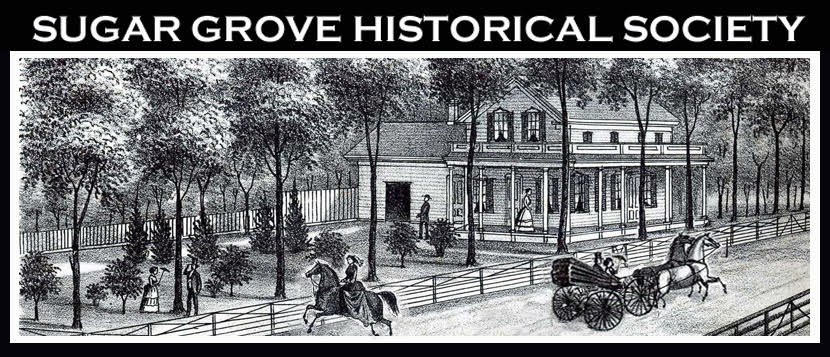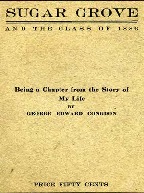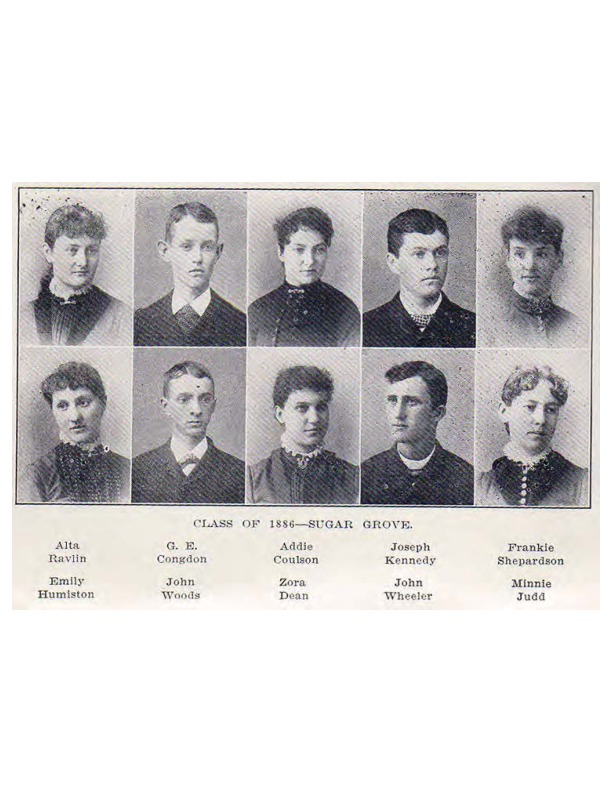Dublin Core
Title
Book: "Sugar Grove and the Class of 1886: Being a Chapter from the Story of My Life by George Edward Congdon", 1911
Subject
[no text]
Description
“I cannot remember all of the buildings in town but my memory is sufficiently definite so that I can give the reader a fairly good picture of the village as it was at that time. “
“First there was the depot built beside one of the highways of the township, and opposite it on the south side of the track the usual grain elevator. Then on the north was the store of J.S. Miller and adjoin it on the same side of the highway was a blacksmith’s shop.…Across from Mr. Miller’s store was Uncle Tom’s Cabin, as it has always been called, in honor of Thomas Judd, the prime mover in the founding of the school. This was at once the village hotel and the boarding house and dormitory for the students. However at that time the transient boarders were few and far between. A few rods to the north was Mr. Hall’s store, a long two-story structure, with broad steps in front and a long flight of stairs on the south side of the building leading up to the second floor which was the home of Mr. Hall and his family. For the village of Sugar Grove the store was the rival of the metropolitan department stores. In front of you as you entered was the village post-office. On the right was a considerable display of drugs and medicines, and on the left dry-goods and notions. Farther back was a supply of groceries, and hardware, and on one block of shelves was a stock of school books and school supplies. In the rear of the store was a small printing press, both probably with the idea of giving instruction in the printer’s art to any student you desired it, and which Mr. Hall used in a small way in actual business.”
…
“And now a little as to the history of the school to which I was introduced…[Thomas Judd, a wealthy farmer of the township] had long been desirous that an agricultural school should be started in that town and at one time offered one hundred and sixty acres of land in furtherance of the project. At that time the scheme was considered visionary and even now there were doubters. It was only after the town had voted to rebuild [the old school that burned down] on the old site and work had been commenced that he prevailed upon his fellow citizens to reconsider the vote and adopt his plans. Then it was that a delegation of citizens visited Mr. Frank Hall, at that time teaching in Aurora and with him worked out the plans for the school. Several large amounts were pledged, a grand picnic was held at which the subscriptions were largely increased, the building erected and the school opened for work in the fall of 1875. The school was called the Sugar Grove Normal and Industrial School and the hopes of its founders are fairly well set forth in the following from an Aurora paper: ‘The pupils will be instructed in the natural sciences, including the science of farming in all its various branches, embracing the history and usefulness of the different breeds of improved stock, the methods of improving and preserving the quality of farm stock and crops of all kinds, also the science of growing crops, the fertilizers required for different kinds of grain, etc.’ “
Source: "Sugar Grove and the Class of 1886: Being a Chapter from the Story of My Life by George Edward Congdon", 1911
“First there was the depot built beside one of the highways of the township, and opposite it on the south side of the track the usual grain elevator. Then on the north was the store of J.S. Miller and adjoin it on the same side of the highway was a blacksmith’s shop.…Across from Mr. Miller’s store was Uncle Tom’s Cabin, as it has always been called, in honor of Thomas Judd, the prime mover in the founding of the school. This was at once the village hotel and the boarding house and dormitory for the students. However at that time the transient boarders were few and far between. A few rods to the north was Mr. Hall’s store, a long two-story structure, with broad steps in front and a long flight of stairs on the south side of the building leading up to the second floor which was the home of Mr. Hall and his family. For the village of Sugar Grove the store was the rival of the metropolitan department stores. In front of you as you entered was the village post-office. On the right was a considerable display of drugs and medicines, and on the left dry-goods and notions. Farther back was a supply of groceries, and hardware, and on one block of shelves was a stock of school books and school supplies. In the rear of the store was a small printing press, both probably with the idea of giving instruction in the printer’s art to any student you desired it, and which Mr. Hall used in a small way in actual business.”
…
“And now a little as to the history of the school to which I was introduced…[Thomas Judd, a wealthy farmer of the township] had long been desirous that an agricultural school should be started in that town and at one time offered one hundred and sixty acres of land in furtherance of the project. At that time the scheme was considered visionary and even now there were doubters. It was only after the town had voted to rebuild [the old school that burned down] on the old site and work had been commenced that he prevailed upon his fellow citizens to reconsider the vote and adopt his plans. Then it was that a delegation of citizens visited Mr. Frank Hall, at that time teaching in Aurora and with him worked out the plans for the school. Several large amounts were pledged, a grand picnic was held at which the subscriptions were largely increased, the building erected and the school opened for work in the fall of 1875. The school was called the Sugar Grove Normal and Industrial School and the hopes of its founders are fairly well set forth in the following from an Aurora paper: ‘The pupils will be instructed in the natural sciences, including the science of farming in all its various branches, embracing the history and usefulness of the different breeds of improved stock, the methods of improving and preserving the quality of farm stock and crops of all kinds, also the science of growing crops, the fertilizers required for different kinds of grain, etc.’ “
Source: "Sugar Grove and the Class of 1886: Being a Chapter from the Story of My Life by George Edward Congdon", 1911
Identifier
[no text]
Date
[no text]
Creator
Lisa
Language
[no text]
Rights
[no text]
Format
[no text]
Relation
[no text]
Source
[no text]
Publisher
Hiawatha Kansas, Ewing Herbert, Printer 1911
Contributor
[no text]
Type
[no text]
Coverage
[no text]


